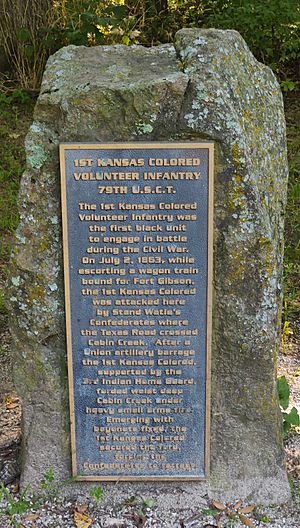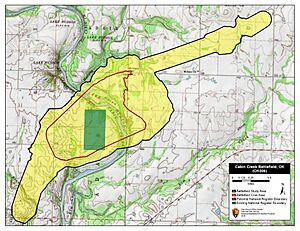Cabin Creek battlefield facts for kids
The Cabin Creek battlefield is where two important battles happened during the American Civil War. These battles took place in the Cherokee Nation, in what is now Oklahoma. The site was where a major road called the Texas Road crossed Cabin Creek, near the town of Big Cabin, Oklahoma. Both battles were started by the Confederate Army. Their goal was to stop Union Army supply trains.
The first battle was a raid by a group of Confederate soldiers in July 1863. They tried to stop a Union supply train heading to Fort Gibson. But they failed to stop the Union soldiers. This allowed the Union to win the Battle of Honey Springs later that month. The second battle happened in September 1864. This was another Confederate raid on a Union supply train. This time, the Confederates captured a lot of valuable supplies. They took over a million dollars worth of mules, wagons, and other goods. However, this victory came too late to change the outcome of the war. Confederate General Stand Watie led the attackers in both raids.
Contents
Saving the Battlefield Site
A young Cherokee man named Joseph Martin bought land at Cabin Creek in 1840. This land became his headquarters for a large ranch called Pensacola. By 1860, he also had a stop on his property along the Texas Road. Travelers could buy food and supplies there and get their wagons fixed. Part of this land later became the Cabin Creek battleground.
Early Efforts to Protect the Land
People didn't show much interest in saving the battle site until 1958. That's when the Vinita Chapter of the United Daughters of the Confederacy (UDC) decided to buy some land. They wanted to get a 10-acre piece of ground. This land is now considered the main part of the battlefield. The UDC group talked to the landowner and agreed on a price of $300. The UDC chapter spent three years raising money. They finally bought the land in 1961. Later that same year, they gave the land to the Oklahoma Historical Society (OHS).
Adding Monuments and Reenactments
The same UDC chapter gave a monument to celebrate the Confederate victory of 1864. This was for the 100th anniversary of the event. The OHS created a circular drive in the park. They also added small monuments to show where the two armies fought. Interest in the park faded for some years. Because of this, the park wasn't well-maintained. Many monuments were damaged by vandals.
In 1992, the OHS and the Grand Lake Chamber of Commerce worked together. They put on a reenactment of the battles. It was a big success, attracting about 15,000 visitors. People who acted out the battles came from many parts of the United States. The OHS was encouraged by this public response. They decided to repeat the event every three years. A non-profit group called "The Friends of Cabin Creek Battlefield, Inc." was formed. This group worked to clean up the park. They repaired damaged monuments and added trash cans and park benches. The park became a day-use only area. Its gates are unlocked in the morning and locked in the evenings every day of the year.
Expanding the Park
The Civil War Trust (which is part of the American Battlefield Trust) bought more land in 2011. They added 88 acres to the park. Now, the park covers most of the original battlefield of the First Battle of Cabin Creek. A local newspaper reported that more improvements were still needed. These included walking trails and exhibits. These exhibits would explain the conflicts within the Native American tribes during the war. The newspaper called its article "The Third Battle of Cabin Creek."



